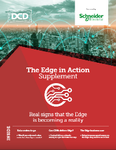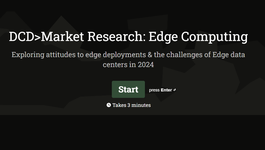Amidst the pandemic as digital technologies scaled nearly overnight to satisfy remote work and learning needs during global lockdowns, Edge colo companies had to up the ante to meet the global connectivity needs while maintaining uninterrupted, 24x7 uptime and adhering to social distancing rules.
Fast-forward to post-pandemic back-to-work status, rolling out thousands of pre-designed modular data centers, or micro data centers (MDCs), remains as the best option–since at the network edge the condensed footprint also means more powerful, flexible computing capacity. As part of a distributed computing topology, Edge computing pulls information processing closer to the physical location, enabling users (and things) to connect with the networked digital world, faster, safer and for extended periods; all with a distributed redundancy.
To rapidly scale MDC operations nationwide and globally, facility operators need a unified solution to consolidate data from across all their siloed systems and globally distributed sites to monitor and manage this un-manned infrastructure from afar. Since the internet's wired/wireless centralized content and peering model can’t solve the performance needs of intelligent devices, creating a distributed, carrier-neutral colocation platform and ecosystem helps expedite and resolve shortfalls of today’s internet latency, capacity, and security.
IoT technology lift off
One of the major drivers for the edge market demand is our increased compute-intensive technologies of IoT, AI, and streaming services; just to name a few. Telecom companies are expected to create Multi-access Edge Computing (MEC) environments which are distributed architectures capable of pulling data storage closer to the end-user, reducing latency, and increasing security and redundancy. In effect, this creates an ISP hub highly attuned to the onslaught of new data sources connected to cloud ecosystems upstream and allowing for more split-second operations to occur locally. While very similar to a full-size data center, MDCs have drastically lower operational costs and latency, as well as operating autonomously powered by IoT automation across the MDC portfolio. Most importantly, they are close to where these split-second computing choices have to be made instead of the data traversing the region or globe to a full-size data center.
This increased computing power, and lowered data processing latency, satisfy the IoT application demands, as more devices onboard into ecosystems to enable IoT applications and analytics. With 75 billion IoT devices expected to be installed by 2025, these devices power Artificial Intelligence (AI) decisions at the edge, as well as begin to foster Machine Learning algorithms to improve a range of IoT driven applications from autonomous navigation on the ground and in the air, to enabling more progressive operational characteristics of data-intensive applications.
MDCs scale seamlessly with IoT platforms
MDCs are not an either/or, but a partner to colocation. Working together Colo and MDCs deliver the speed, consistency and reliability needed to cache and compute at the edge–while greatly mitigating risks and infrastructure complexity. Yet MDCs pose a problem. They do not have humans readily available to address issues. These un-manned sites can only be impactful with highly reliable, simple-to-deploy monitoring systems that can scale and offer a virtual ‘boots on the ground’ approach to operation of MDCs. To meet these needs, IoT Platforms deployed at edge and in Colo data centers allow the simplification and unification of these distributed infrastructures. IoT platforms, unlike EMS/BMS style legacy solutions, rapidly scale affordably with capabilities of managing thousands of globally distributed locations. These systems swiftly enable operators to remotely operate these facilities without any truck rolls–fostering operational expense efficiency and help foster energy management, security, and asset life-cycle management through long-term operational trending.
Poised as the most cost-effective solution to disaster, and more recently, pandemic-proof critical assets, IoT platforms’ alert notifications prevent and divert risks before they cause costly operational disasters or outages. IoT platforms, born out of the I.T. industry (instead of the BMS space) allow operators and owners to modify and adapt to change to meet fluctuating business needs, environments, or equipment. Most importantly, IoT platforms work with what is already there. There is often little value in replacing systems and sensing technology already deployed. IoT platforms excel at:
- Avoiding the need to rewire, replace, or re-architect and program existing subsystems (Like HVAC, surveillance, access control, generator operations, etc.
- Adding an abstraction layer on top of legacy solutions allowing for actionable data and historical trending of data from all systems (compared to each system offering only its silo of analytics).
- Improved issue response to predictive maintenance, security, uptime, and control of OpEx.
- Offering a unified dashboard of a single pane of glass for seamless, efficient monitoring and management of all existing equipment and systems, regardless of manufacturers–and from across geographically distributed locations.
- Allowing operators to tap into and conduct real-time troubleshooting to maintain uptime and business continuity.
- Fostering through data consistent commissioning and predictive maintenance philosophies across a portfolio of locations.
- Allowing for a vastly more affordable installation and scaling experience compared to traditional multisite operation frameworks.
Meeting Edge-anywhere demands
Providing rapidly deployed “edge anywhere” colocation solutions, one company, EdgeMicro meets the growing demand for the content delivery network (CDN), gaming, Hyperscalers, integrators and as-a-service providers. They are focused on Tier 2 and 3 colocations at the edge–where a large concentration of internet drains, connectivity exchanges, and data center campuses are not located, yet where customers want to provide content to subscribers.
Taking a proven concept in colocation, EdgeMicro has shrunk it to a small form factor. Putting it into underserved markets where publication or large internet exchanges don't exist but working with regional ISPs, cable companies, and ILECs traffic is kept local.
“As we come out of COVID, we have seen increased demand for higher density, distributed client workloads and applications,” Jason Bourg, EdgeMicro’s VP of Revenue and Strategy explains. “Our ability to provide 64KW up to 1MW of new capacity in a matter of weeks along with our existing five neutral colocation Edge data centers enable our clients to solve multiple use cases quickly and effectively while alleviating the burden of site selection, construction, maintenance and FTE needed to run a data center.”
Partnering with IoT Platform solution provider, Radix IoT, means EdgeMicro’s proven process and procedures enable client success at the Edge by integrating simple-to-deploy, hardware agnostic and secure IoT platforms. This is key to MDCs’ success as edge sites proliferate globally. These hardware/software solutions allow edge data center users to:
- Easily install in an edge location or telco shelter–regardless of location/existing systems.
- Collect, organize, and monitor data sets from distributed critical infrastructure at remote, lights-out facilities.
- Use intuitive, secure cloud portals for data lakes to be sorted and stored across globally deployed edge sites with an authorization-based access to the enterprise data collection in a single documented API for web-based, micro-services analytics and third-party applications.
- Enable change management process–from adding more rack PDUs to UPS equipment and others to meet customer needs.
- Easily scale to manage thousands of globally distributed facilities.
- Make seamless, simple, or complex physical plant changes and updates to MDCs concurrently as scaling.
- Limit or eliminate diagnostic, on-site truck-rolls.
- Consolidate management of all systems–not replacing BMS, or purpose-built solutions for individual trades.
- Consolidate datasets and seamlessly connect to external micro-service analytics, software tools, or BI engines for actionable analytics not offered by a single trade’s data silo.
- Easily adapt to specific needs of critical facilities’ monitoring or control requirements.
As connected devices multiply and demand ever more connectivity and uptime, Edge data centers will continue to proliferate. IoT Platforms’ cost-effective solutions will expedite rapid provisioning of newly deployed facilities globally, simplifying distributed infrastructure management for providers while addressing latency and backhaul challenges for mobile network operators and content providers serving mobile/internet users.
Amidst the pandemic lock-downs global operations continued with no interruptions due in greater part to colocation solutions delivering the speed, consistency, and reliability needed to cache and compute at the edge at scale. IoT platforms now, and into the future, will enable this technology to flourish to meet the ever-growing demands of the market.





